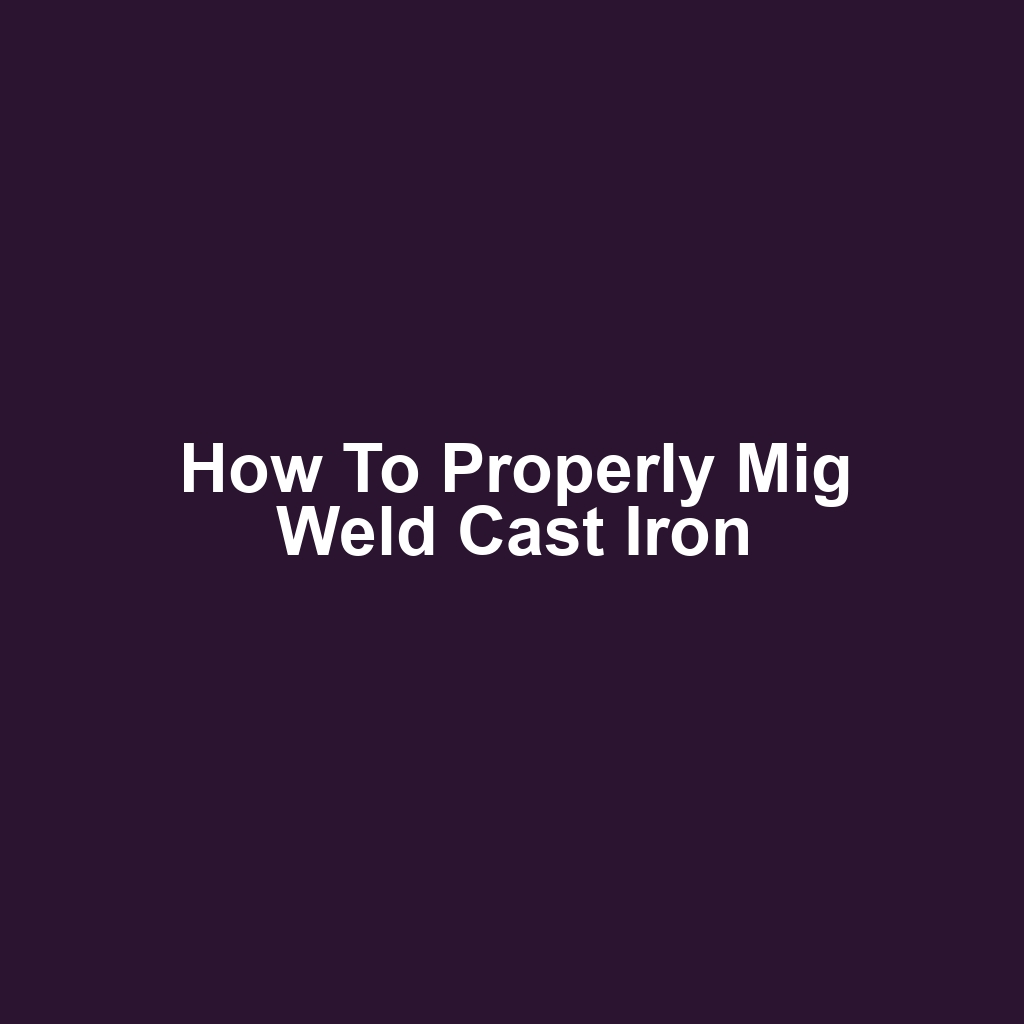When I first started working with cast iron, I quickly realized that MIG welding it requires a specific approach. I often found myself unsure about the best practices, which is why I decided to research how to properly mig weld cast iron. Through my experience, I’ve learned that preparation and the right materials make all the difference in achieving a strong, lasting weld. In this article, I’ll share the techniques and tips I’ve developed to help you tackle this challenging material with confidence. Let’s dive into the essential steps to ensure your cast iron welding projects are successful.
Key Takeaways
Thoroughly clean and inspect cast iron surfaces before welding to ensure a smooth and defect-free area.
Choose the appropriate filler metal, such as ER70S-6 or nickel-based options, based on the thickness and type of cast iron.
Adjust MIG welder settings for optimal penetration and control, including voltage, wire feed speed, and gas flow rate.
Slow cooling and post-weld cleaning are essential to prevent cracking and ensure weld integrity.
Preparing the Cast Iron for Welding
I’ve found that thoroughly cleaning the cast iron surface is essential before I start welding. I usually use a wire brush to remove any rust and dirt. Once that’s done, I make sure there are no oils or grease left on the surface. I often wipe it down with a solvent to ensure it’s completely clean. I also check for any cracks or defects in the metal. If I find any, I’ll grind them out to create a smooth surface. It’s important to preheat the cast iron before welding, so I typically use a torch. I keep the heat even to avoid warping. After everything’s prepped, I feel confident moving on to the welding process.
Choosing the Right Filler Metal
Choosing the right filler metal is crucial for achieving a strong and durable weld on cast iron. I’ve found that using an ER70S-6 wire often works best for most cast iron applications. It’s got the right balance of strength and ductility that I need for a solid weld. When I’m dealing with thicker sections, I sometimes opt for a nickel-based filler, like ERNi-1. It helps with preventing cracking and provides a good fusion with the cast iron. I also consider the specific type of cast iron I’m working with; some require a different approach. For gray cast iron, I lean towards using a low-hydrogen filler wire. I always double-check the manufacturer’s recommendations for the best results. Ultimately, the right filler metal makes all the difference in my welding projects.
Adjusting MIG Welder Settings
Adjusting my MIG welder settings is crucial for achieving a strong weld on cast iron. I’ve learned that the voltage needs to be set higher than usual to penetrate the thicker material. I usually start with a wire feed speed that’s a bit faster to ensure a steady arc. The gas flow rate also plays a big role, so I make sure it’s around 20 to 25 cubic feet per hour. I often find that preheating the cast iron helps with the welding process, too. It’s essential to monitor the arc length; I keep it short for better control. I’ve noticed that adjusting the torch angle can improve the weld bead appearance. I always test the settings on scrap pieces before tackling the main project. By fine-tuning these elements, I can achieve the durability I need in my welds.
Welding Techniques for Cast Iron
When it comes to welding cast iron, I’ve found that using the right techniques is crucial for achieving strong results. I often rely on common welding methods along with specific preheating and cooling techniques to prevent cracking. With these strategies in mind, I’m ready to dive into the details.
Common Welding Methods
Common welding methods can significantly impact the quality of the final product, and I always consider factors like material compatibility and joint design. I usually prefer MIG welding for its speed and versatility when working with cast iron. Sometimes, I combine it with TIG welding for more delicate sections that require precision. I’ve noticed that using a nickel-based filler metal can enhance the weld’s strength and reduce the risk of cracking. Overall, I ensure that I follow proper techniques to achieve the best results.
Preheating and Cooling Techniques
Preheating the cast iron before welding helps to minimize the risk of cracking, and I always make sure to monitor the temperature closely. I usually preheat to around 500 degrees Fahrenheit, ensuring even heat distribution. Once I start welding, I try to maintain a steady pace to avoid overheating the material. After welding, I cool the piece slowly, often by wrapping it in insulation or using a controlled cooling process. This method helps me achieve a more reliable and durable weld.
Post-Weld Treatment and Inspection
I’ve found that proper post-weld treatment and inspection can significantly improve the strength and durability of my cast iron welds. After finishing a weld, I let the piece cool down slowly to avoid cracking. Then, I clean the weld area to remove any slag or impurities. I often use a wire brush or grinder for this step. Once it’s clean, I inspect the weld for any imperfections or defects. If I spot any issues, I address them immediately. After inspection, I sometimes apply a stress-relief treatment to enhance the weld’s integrity. I also document the process for future reference. This routine has made a noticeable difference in the quality of my projects.
If you’re looking to enhance your metal building experience beyond just welding techniques, I highly recommend checking out this helpful guide on tips for getting cell service in a metal building. Proper connectivity can make all the difference in your workspace, and you can find valuable insights by visiting click. Don’t miss out on improving your overall efficiency!
